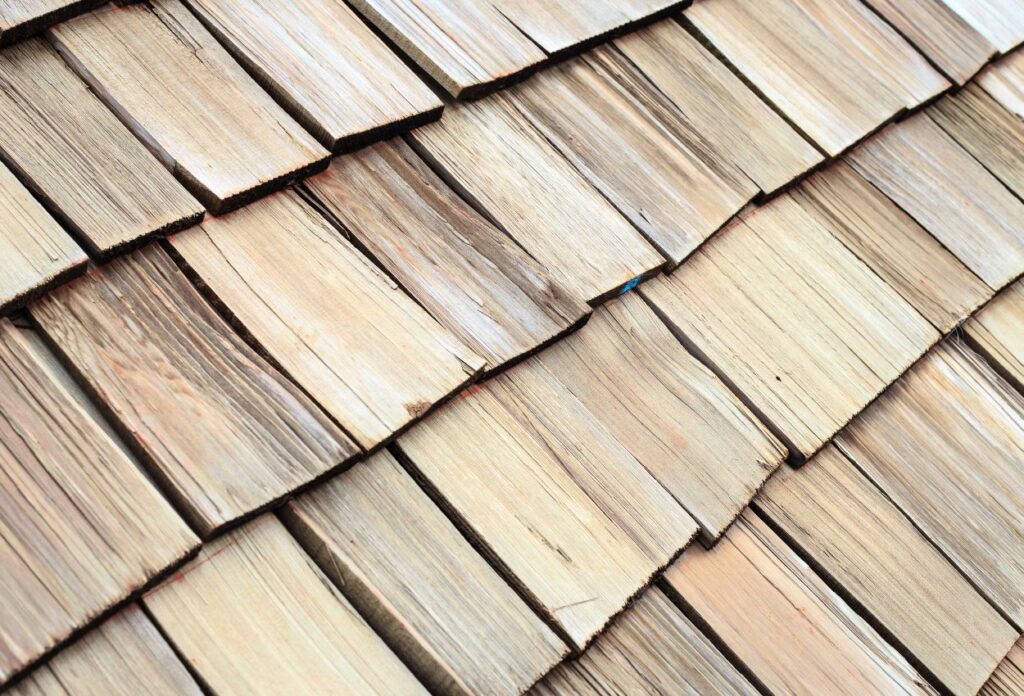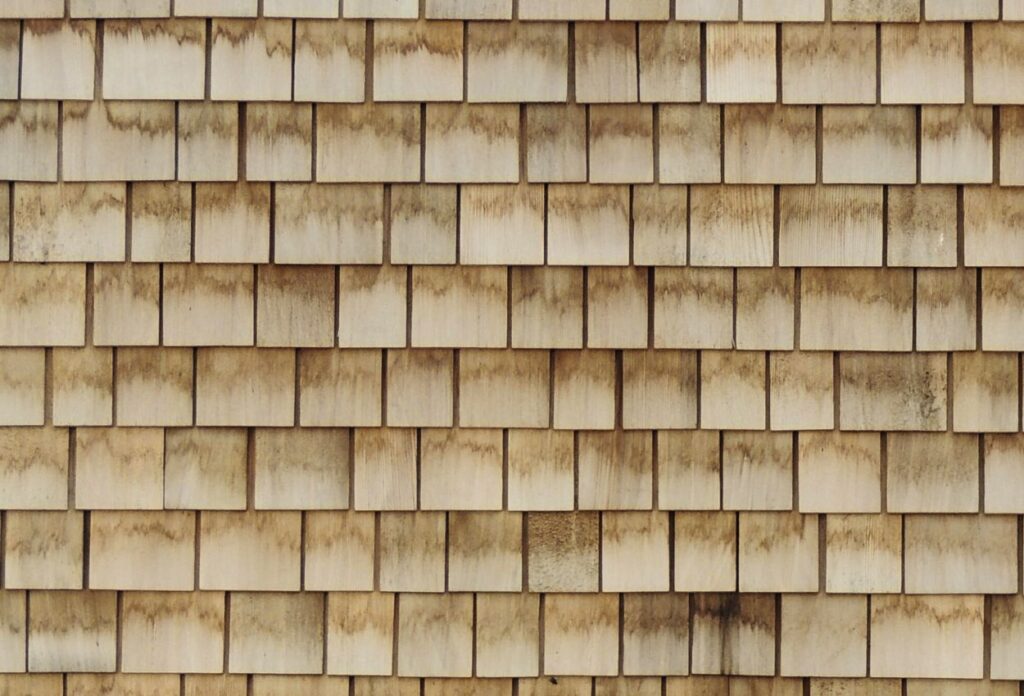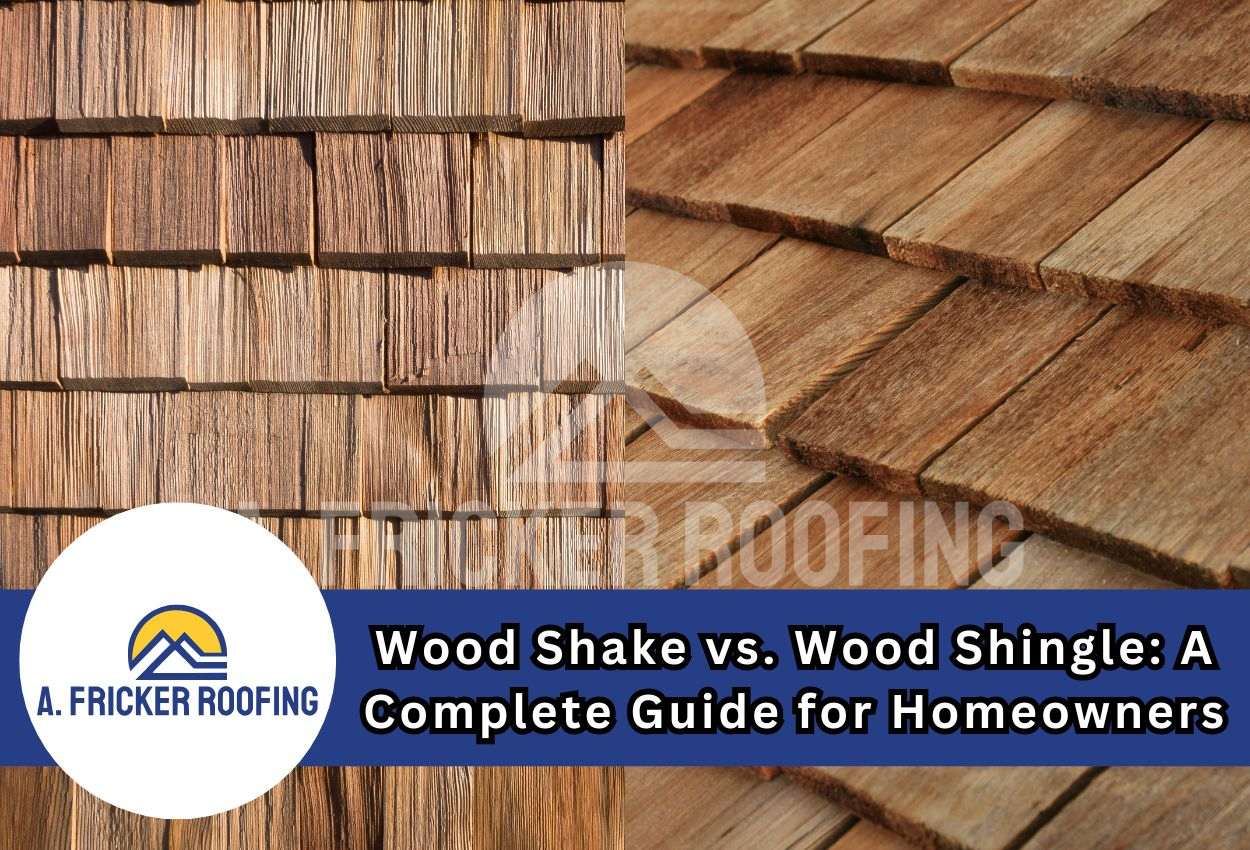Few roofing materials have a distinct appeal as does a roof made of natural wood. When it comes to wood roofing, homeowners often hear the terms ‘wood shake” and “wood shingle” used interchangeably. While they may seem similar at a glance, they have distinct characteristics that affect appearance, durability, and, of course, how much they cost overall.
If you are considering a wood roof for your Oklahoma home, understanding these differences is crucial to making an informed decision.
What Are Wood Shakes and Wood Shingles?
Let’s take a look at how each type of wood roofing material differs.
Wood Shakes

Wood shakes are thicker, more textured, and have a rough, rugged appearance. They are split from logs rather than sawn, giving them an uneven, natural look. This handcrafted quality makes shakes ideal for homeowners who want a rustic aesthetic.
Shakes come in two types:
Hand-split shakes – These are the most popular types of wood shake roofing on the market. The wood shakes are split on one or both sides, resulting in a rough, irregular surface that looks quite distinctive and appealing.
Taper-sawn shakes – Though not as common as hand-split shakes, some wood shakes are taper-sawn. These are sawn on both sides but remain thicker than standard shingles, offering a smoother yet still textured look.
Pros Of Wood Shakes
- Distinctive, natural, and rustic appearance
- Thicker and more durable than shingles
- Excellent resistance to strong winds when properly installed
- Increases curb appeal and home value
Cons of Wood Shakes
- Higher initial cost
- Requires more maintenance to prevent decay and moisture damage
To learn more about wood shake roofs, including their benefits, visit our guide: Everything You Need to Know About Wood Shake Roofs.
Wood Shingles

Wood shingles, on the other hand, are machine-sawn, creating a uniform thickness and smooth surface. They provide a more refined and polished appearance, which is often preferred for homes with traditional or contemporary designs.
Shingles are cut with precise angles and are available in different grades, ensuring consistency in size and thickness.
Pros of Wood Shingles
- Uniform, polished look suitable for various architectural styles
- More budget-friendly compared to shakes
Cons of Wood Shingles
- Slightly less durable than shakes due to being thinner
- Less resistant to wind damage compared to shakes
Differences Between Wood Shake Roofs vs. Wood Shingles
Manufacturing Process
One of the biggest differences in the wood shake vs. shingle debate is how they are manufactured.
Wood Shakes:
Wood shakes are typically split from logs either by hand or with machines. This process preserves the natural grain and texture of the wood, resulting in a rough surface. The splitting method helps create natural variations that give the shakes a rustic and authentic look. These inconsistencies enhance the overall character of a roof.
Wood Shingles:
On the other hand, wood shingles are sawn using machines to create uniform, smooth pieces. The manufacturing is done in factories with the method focused on producing clean, refined edges.
Appearance
Wood Shakes:
The appearance of wood shakes is distinctively rougher and thicker than that of wood shingles. With their uneven, irregular edges, no shake looks the same. These shakes lend a natural, rustic feel to a building. This texture can give a home a more traditional or rugged appearance, often chosen for houses in rural or rustic settings where a more natural appearance is desired.
Wood Shingles:
In contrast, wood shingles have a smooth, uniform surface with clean, straight edges. Their thinner, consistent thickness results in a neat, refined appearance. This can give the home a more polished look, making wood shingles a good choice for more formal, modern, or classic designs.
Thickness and Wood Dimensions
Wood Shakes:
The natural, hand-splitting makes the wood shakes thicker. Shakes tend to have a more substantial feel and provide a more pronounced shadow line on the roof. Because of their extra thickness, shakes are often seen as a more durable option, especially in areas with extreme weather conditions.
Wood Shingles:
Wood shingles are consistently thinner than shakes, with a more uniform width and thickness. They are cut to exact specifications, which allow them to fit neatly together on a roof. This results in a cleaner, more symmetrical look.
Lifespan (Durability Considerations)
Wood Shakes:
Wood shakes generally last longer than wood shingles due to their thicker construction. When properly maintained, shakes can last anywhere from 30 to 40 years, as their thickness makes them more resistant. The irregular grain of the wood also helps shakes stand up better to harsh weather.
Wood Shingles:
While wood shingles also offer good durability, they generally have a slightly shorter lifespan compared to shakes. On average, wood shingles can last around 25 to 35 years, depending on environmental conditions and maintenance.
Both of these require constant maintenance, so be prepared for that.
Cost Considerations
Wood Shakes:
Wood shakes tend to be more expensive than wood shingles due to their thicker, rougher construction and the more labor-intensive manufacturing and installation processes. The raw materials for shakes are also often sourced in a way that preserves their natural, uneven quality, which can increase costs.
You can expect a wood shake roof to cost around $15 to $25 per square foot, with cedar shake costing the highest out of all the different types.
While shakes offer greater durability and an enhanced appearance, their higher price point makes them a more premium option for homeowners.
Wood Shingles:
Wood shingles are typically more budget-friendly than shakes. The manufacturing process is more efficient, and the materials are often easier to handle and install.
A wood shingle roof can cost around $10 to $12 per square foot. Shingles can provide great value, especially for those on a tighter budget.
Installation Process
Wood Shakes:
Installing wood shakes requires a bit more attention to detail due to their thickness and unevenness. Shakes are typically installed with spacing between them to ensure proper airflow and prevent moisture buildup. A layer of felt paper is often placed between the shake layers to protect against water infiltration. The installation process can be more labor-intensive because of the added steps needed to fit the pieces correctly and allow for proper ventilation.
Wood Shingles:
Wood shingles are installed more quickly and with greater precision since they are thinner and have a consistent shape. Shingles are laid in tightly overlapping rows, which creates a smooth, uniform appearance. The installation is generally more straightforward and faster than shakes, and the overlap ensures a watertight seal. But you still need an experienced roofing contractor for the job.
Maintenance Tips for Wood Roofs
As we discussed, both wood shakes and shingles are prone to damage and need regular check-ups. Regardless of which option you choose, proper maintenance is key to ensuring a long lifespan. Here are some of the things you can do:
- Regular Inspections: Look for signs of wear, cracks, or loose shakes/shingles.
- Keep the Roof Clean: Remove debris like leaves and branches to prevent moisture buildup.
- Apply Protective Coatings: Use sealants and preservatives to prevent water damage and insect infestations.
- Ensure Proper Ventilation: Good airflow helps reduce the risk of mold and mildew.
- Roof Repairs: Address any damaged or missing pieces as soon as possible to prevent further issues.
Final Thoughts
Wood shake roofs are a bit more expensive to install but offer greater durability, charming looks, and a longer lifespan. If you want to improve your home with a new wood shake roofing system, look no further than the team of A. Fricker Roofing and Waterproofing. We are premier wood shake roofing contractors serving Tulsa and the surrounding areas of Oklahoma. We also offer free roof inspections for existing wood shake roofs.
Contact us today at (918) 402-7167 or visit our instant quote page for a free estimate.

